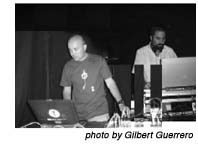Nortec Toward Home
by Melissa Satley
Ramon Amezcua, aka Bostich, the godfather of Norteño/techno music, stands behind a laptop, cranking out the raw sounds of tuba and snare drums with a pulsing electronic beat, while a hallucinatory video projects disembodied accordions and a cartoon pistolero with a huge pot leaf on his belt buckle in a nod to Tijuana’s narco underbelly.
As if in a trance, the crowd at the Vortex, an Austin theater, stares at the collage of border kitsch until Amezcua launches into his breakout tune, “Polaris.” It’s a dance floor favorite that masterfully blends tambora style tuba riffs with aggressive syncopated snare beats. Unable to resist, the audience hits the dance floor. Just when his syncopated rhythms have won them over, Bostich’s Macintosh laptop stutters, then crashes. “Weird,” he says, as all eyes rest on him. He shrugs, reboots, and the show goes on.
It was Bostich’s tune “Polaris” which put Norteño/techno—christened Nortec by its creators—on the musical map. Back in 1999, fellow Tijuana electronic musician Pepe Mogt hit upon the idea of recording samples from his favorite of the many Norteño trios that haunt the seafood restaurants and discos on Avenida Revolucion in the heart of Tijuana, Mexico. Excited by the prospect of mixing the two disparate styles of music, Mogt invited Amezcua to experiment with the Norteño/techno sound. Amezcua came up with “Polaris,” which became Nortec’s breakout hit.
Gradually, other electronic musicians in Tijuana took up the Nortec banner and they formed a collective that grew to include graphic artists, clothing designers, and video jockeys, all reflecting the border aesthetic of the first world/third world collision.
“Tijuana is an ugly city full of chaos and it’s very badly planned,” says Fernando Corona, another Tijuana musician who performs under the name Terrestre. “But there is also a good side to it, because the city is always in transit and there is a lot of energy there.”

Corona plays his 45-minute set before Bostich. Both Bostich and Terrestre are at the Vortex as part of the CinemaTexas Eye + Ear Festival. His set includes such tracks as “Rancho Tron” and “Lazer Metrayeta,” which, he says, highlight the aggressive vibe of Tijuana with their digital glitches and folklorico touches. Terrestre’s track “El Lado Oscuro de mi Compadre” captures the raucous drunkenness of a fistfight at a Mexican wedding with menacing tubas and the sharp crack of a cowbell. To punctuate his music, Corona projects images from his city—maquila parades and a drunken campesino singer reeling through the city’s red light district. “Some people get our music and our visuals and others don’t,” he shrugs. “Tijuana is the portal between the third world and the American dream. It’s a place where America finds cheap labor and maquila assembly lines. In many ways both sides of the border benefit from Tijuana and both of them suffer.”
Both Bostich and Terrestre are children of the border who grew up on punk rock imported from the States and the brass bands of La Tambora Sinaolense from northwestern Mexico. They added secondhand synthesizers, and the Nortec aesthetic was born. “I always listened to the radio stations from San Diego where you could hear funk, disco, and Kraftwerk,” says Amezcua. “I was really into Tangerine Dream.”
It wasn’t long before Chris Blackwell, the legendary founder of Island Records, caught on to the Nortec vibe. One night, the record label magnate heard a homemade CD sampler from the Nortec Collective at a Miami Beach party. He liked what he heard and signed the collective to a recording deal for three compilation CDs and one album for each of the Nortec members. The Nortec Collective has since released their eponymously titled Nortec Collective Vol. 1 to rave reviews. Since then, both Bostich and Terrestre have traveled the world playing at concerts and music festivals. Bostich’s tracks have been featured in Volvo and NFL commercials. Meanwhile, Terrestre has worked on remixes for the Kronos Quartet and Enrique Iglesias. Vol. 2 of the Nortec Collective is slated to be released in early 2004 on Blackwell’s current label, Palm Pictures.
“When Nortec started I never imagined it would take me around the world,” Amezcua muses. An unassuming dentist by day, the 40-year-old Bostich is married and the father of four children. He says that increasingly Nortec has taken him away from his family and his dental practice. “I was in LA yesterday, Austin today, and tomorrow I leave for Brazil,” he says, smiling. “But, if you’d like to make an appointment, I will be in the office next week.”
Both Corona and Amezcua say they want to continue pushing the musical borders of the Nortec aesthetic. Amezcua has a new project called Point Loma in which he works more with analog synthesizers and uses fewer sample loops. “It’s not as playful as Bostich,” he says. Corona has left the collective altogether and often performs under the name of Murcor, mixing chamber and classical music with digital processing. While Corona says he is pulling away from the Norteño aspects of Nortec, he will never entirely give up the traditional sounds of northern Mexico. “Nortec music is honest because it reflects the world around us,” he says. “That’s why we play it.”
Melissa Sattley is a freelance writer in Austin.


